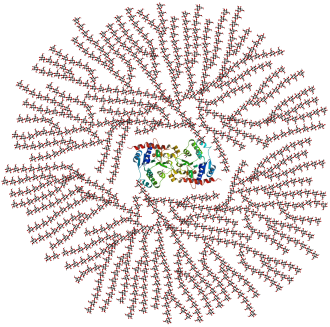Glycogenin: Difference between revisions
CSV import Tags: mobile edit mobile web edit |
CSV import Tags: mobile edit mobile web edit |
||
| Line 1: | Line 1: | ||
{{Short description|An enzyme involved in glycogen biosynthesis}} | |||
{{Use dmy dates|date=October 2023}} | |||
== | ==Glycogenin== | ||
[[File:Glycogen_structure.svg|thumb|right|300px|Structure of glycogen showing the core protein glycogenin.]] | |||
'''Glycogenin''' is a [[protein]] that plays a crucial role in the [[biosynthesis]] of [[glycogen]], a multi-branched polysaccharide that serves as a form of energy storage in animals and fungi. Glycogenin acts as a [[primer (molecular biology)|primer]] for the initiation of glycogen synthesis by catalyzing the addition of glucose molecules to itself, forming a short chain that serves as a substrate for further elongation by [[glycogen synthase]]. | |||
==Structure== | ==Structure and Function== | ||
Glycogenin is a | Glycogenin is a [[glycosyltransferase]] enzyme that is capable of autoglycosylation, meaning it can attach glucose molecules to its own [[tyrosine]] residues. This self-glucosylation is the first step in the formation of a glycogen particle. Glycogenin remains covalently attached to the reducing end of the glycogen molecule, acting as a core around which the glycogen structure is built. | ||
The enzyme is composed of two identical subunits, each capable of binding and transferring glucose from [[UDP-glucose]] to the other subunit. This process continues until a short chain of approximately 8 glucose units is formed, at which point glycogen synthase takes over to extend the chain further. | |||
==Role in Glycogen Metabolism== | |||
Glycogenin is essential for the de novo synthesis of glycogen. Without glycogenin, glycogen synthase would not have a starting point to begin polymerizing glucose into glycogen. The presence of glycogenin ensures that glycogen synthesis can occur even when glycogen stores are depleted. | |||
In the [[liver]] and [[muscle]] tissues, glycogen serves as a readily available source of glucose to maintain blood sugar levels and provide energy during periods of increased demand. Glycogenin's role in initiating glycogen synthesis is therefore critical for maintaining energy homeostasis in the body. | |||
==Clinical Significance== | ==Clinical Significance== | ||
Mutations in the gene encoding glycogenin can lead to glycogen storage diseases | Mutations in the gene encoding glycogenin can lead to glycogen storage diseases, which are characterized by the abnormal accumulation or deficiency of glycogen in tissues. These conditions can result in a variety of symptoms, including muscle weakness, fatigue, and hypoglycemia. | ||
==Related | ==Related pages== | ||
* [[Glycogen synthase]] | |||
* [[Glycogen phosphorylase]] | |||
* [[Glycogen storage disease]] | |||
* [[Carbohydrate metabolism]] | |||
[[Category:Enzymes]] | [[Category:Enzymes]] | ||
[[Category: | [[Category:Carbohydrate metabolism]] | ||
Latest revision as of 11:21, 15 February 2025
An enzyme involved in glycogen biosynthesis
Glycogenin[edit]

Glycogenin is a protein that plays a crucial role in the biosynthesis of glycogen, a multi-branched polysaccharide that serves as a form of energy storage in animals and fungi. Glycogenin acts as a primer for the initiation of glycogen synthesis by catalyzing the addition of glucose molecules to itself, forming a short chain that serves as a substrate for further elongation by glycogen synthase.
Structure and Function[edit]
Glycogenin is a glycosyltransferase enzyme that is capable of autoglycosylation, meaning it can attach glucose molecules to its own tyrosine residues. This self-glucosylation is the first step in the formation of a glycogen particle. Glycogenin remains covalently attached to the reducing end of the glycogen molecule, acting as a core around which the glycogen structure is built.
The enzyme is composed of two identical subunits, each capable of binding and transferring glucose from UDP-glucose to the other subunit. This process continues until a short chain of approximately 8 glucose units is formed, at which point glycogen synthase takes over to extend the chain further.
Role in Glycogen Metabolism[edit]
Glycogenin is essential for the de novo synthesis of glycogen. Without glycogenin, glycogen synthase would not have a starting point to begin polymerizing glucose into glycogen. The presence of glycogenin ensures that glycogen synthesis can occur even when glycogen stores are depleted.
In the liver and muscle tissues, glycogen serves as a readily available source of glucose to maintain blood sugar levels and provide energy during periods of increased demand. Glycogenin's role in initiating glycogen synthesis is therefore critical for maintaining energy homeostasis in the body.
Clinical Significance[edit]
Mutations in the gene encoding glycogenin can lead to glycogen storage diseases, which are characterized by the abnormal accumulation or deficiency of glycogen in tissues. These conditions can result in a variety of symptoms, including muscle weakness, fatigue, and hypoglycemia.